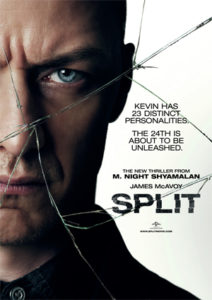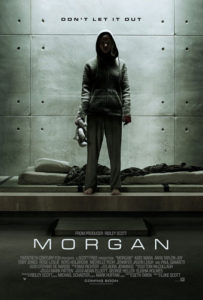Starring: James McAvoy, Anya Taylor-Joy and Betty Buckley
Directed By: M. Night Shyamalan
Rated: PG-13
Running Time: 117 minutes
Universal Pictures
Our Score: 4 out of 5 Stars
Dissociative identity disorder (DID) is more commonly known as split personality disorder (SPD) or multiple personality disorder (MPD). The 90’s was full of daytime talk shows, like Oprah, talking to people who allegedly suffered from the disorder. The TV appearances didn’t add much credence to the ongoing debate over the diagnosis and legitimacy of the mental illness in the scientific and psychological communities. Instead it provided housewives with fodder and a free-pass for Hollywood to rejuvenate one of their favorite horror/thriller tropes. Now in 2017, the disease is back in “Split,” but not without a ferociously unique bite.
It’d be unfair to say that Kevin (McAvoy) kidnapped three women from a suburban Philadelphia mall. There are nearly two dozen other distinct personalities in his brain that could have done it or plotted to do it. However, just like his victims, we’ll soon find out that Dennis did it, but not without a little help. The trio of girls will also meet Patricia, Hedwig, Barry, and a handful of Kevin’s other internal personalities. The one victim that “Split” will tend to focus on is Casey (Taylor-Joy). Unlike her fellow captives, she isn’t crying or screaming for help. Casey seems to not only have a grasp on the situation, but an understanding of Kevin.
Another person with a deep understanding of Kevin is Dr. Karen Fletcher (Buckley). She’s talked with Kevin and nearly all of his personalities, but she’s unaware of his latest emotional developments and actions. She doesn’t view Kevin as a freak of nature, but as someone/something more. She believes Kevin’s DID makes him superhuman in nature, with personalities that not only control his mind, but his body, enhancing or crippling some of his physical attributes. That’s why it worries her that there are rumblings of a 24th personality, nicknamed ‘The Beast’. But is it just rumors between Kevin’s personalities or is there truly another personality, which can climb walls and feast on human flesh, lurking inside Kevin’s brain?
There’s more psychological and emotionally scarring at work in “Split” other than the harmful effects of DID. The mental traumas that Kevin and Casey endured previously before the current abduction predicament are revealed and make them more human. The level of empathy for the inherent villain of the movie, Kevin, is nurtured through light-hearted humor, the innocence of some of his personalities, and the one honest moment where the audience finally meets the real Kevin. McAvoy and Taylor-Joy find wordless ways to make their characters sympathetic, simply by letting tears well up in their eyes or flashing various facial tics at the right moment.
“Split” isn’t quite a return to form for Shyamalan, but more of an evolutionary step in his directing and writing. For years he’s been the twist guy that throws in some jump scares for good measure, but he’s dropped a lot of that in “Split,” relying more on atmosphere and the ability of his actors and actresses. But there’s a light joy to his movie, almost understanding that a movie about a man with DID should surely have a few jokes. Although anyone suffering from the disease and anyone without a funny bone in their body from the medical community would say otherwise. That’s not to say “Split” isn’t without its faults.
It runs a little bit too long and sometimes pushes the envelope without any purpose other than to visually or emotionally upset the audience. That may be Shyamalan tinkering with the formula since he is in new territory. “Split” is a restricted thriller, relying more on drawn out suspense and claustrophobic anxiety. “Split” is a slow boiler with enough tension to make you jump at the slightest movement. It also has Shyamalan working with a tragic villain for the first time since “Unbreakable.” If “Split” is Shyamalan’s apology for everything in between “Signs” and “The Visit,” then apology accepted.




